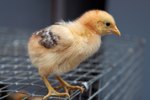Male and female guinea fowl can look nearly identical from the earliest stages of life through sexual maturity. Even then, you'll need a keen eye and ear to know which is which.
Early in Life
The only way to tell gender 100 percent in the early stages of a keet's life is through genetic testing. The process involves sending in a feather, a blood sample or bit of the chick's eggshell to a laboratory. You'll be able to access your test results online using your customer number. This is a less common method of determining a guinea fowl's sex as the cost of one test can be greater than that of several keets.
Look and Listen
If you can wait out the suspense for 8 or 9 weeks, keets begin vocalizing in sounds unique to their sex. Males make a monosyllabic chirp while females use a two-syllable sound that sounds like "buckwheat, buckwheat." As keets develop, males will get larger casques on top of their heads, larger wattles and larger bodies than females. Once they are sexually mature, the males will posture with lowered heads and upraised wings, and a female will respond by lowering herself to the ground to mate.
References
Photo Credits
-
Nico Smit/iStock/Getty Images
Writer Bio
Indulging her passion for vacation vagary through the written word on a full-time basis since 2010, travel funster Jodi Thornton-O'Connell guides readers to the unexpected, quirky, and awe-inspiring.




